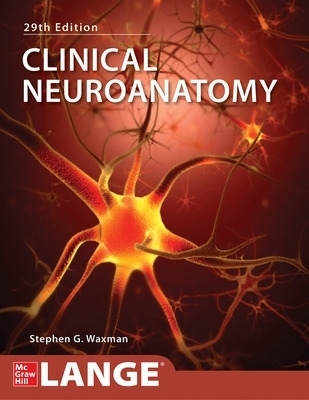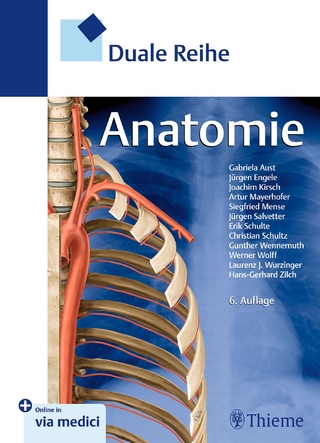
Clinical Neuroanatomy, Twentyninth Edition
McGraw-Hill Education (Verlag)
978-1-260-45235-8 (ISBN)
- Titel ist leider vergriffen;
keine Neuauflage - Artikel merken
A comprehensive, color-illustrated guide to neuroanatomy and its functional and clinical applications
Engagingly written and extensively illustrated, Clinical Neuroanatomy, Twenty-Ninth Edition gets you up to speed on neuroanatomy, its functional underpinnings, and its relationship to the clinic. You’ll learn everything you need to know about the structure and function of the brain, spinal cord, and peripheral nerves. This authoritative guide illustrates clinical presentations of disease processes involving specific structures, explores the relationship between neuroanatomy and neurology, and reviews advances in molecular and cellular biology and neuropharmacology as related to neuroanatomy.
The book is packed with case studies and hundreds of visuals—including CT and MRI scans, block diagrams showing muscle actions, root-by-root and nerve-by-nerve images of sensory areas and muscle intervention, and more—to help you retain critical information.
Essential for board review or as a clinical refresher, Clinical Neuroanatomy features:
• More than 300 full-color illustrations
• An introduction to clinical thinking that puts neuroanatomy in clear clinical perspective
• A discussion of the latest advances in molecular biology and cellular biology in the context of neuroanatomy
• Numerous CT and MRI scans
• Block diagrams illustrating actions of each muscle (essential for the clinical motor examination)
• Hundreds of diagrams and tables encapsulating important information
• Summary listings at the end of each chapter
• Clear and memorable root-by-root and nerve-by-nerve illustrations of sensory areas and muscle intervention
• Coverage of the basic structure and function of the brain, spinal cord, and peripheral nerves as well as clinical presentations of disease processes involving specific structures
• Appendices including The Neurologic Examination, Testing Muscle Function, Spinal Nerves and Plexuses, and Questions and Answers
• Case studies demonstrating how concepts apply to real-world clinical situations
• All the must-know concepts, facts, and structures, and more
• A complete practice exam to assess your knowledge
McGraw-Hill authors represent the leading experts in their fields and are dedicated to improving the lives, careers, and interests of readers worldwide
SECTION I
BASIC PRINCIPLES
1. Fundamentals of the Nervous System
Over-all Plan of the Nervous System
Peripheral Nervous System
Planes and Neuroanatomic Terms
2. Development and Cellular Constituents
of the Nervous System
Neural Development
Neurons
Neuronal Groupings and Connections
Glia
Degeneration and Regeneration
Neurogenesis
3.Signaling in the Nervous System
Membrane Potential
Generator Potentials
Action Potentials
The Nerve Cell Membrane Contains
Ion Channels
The Effects of Myelination
Conduction of Action Potentials
Synapses
Synaptic Transmission
Excitatory and Inhibitory Synaptic Actions
Synaptic Plasticity and Long-Term
Potentiation
Presynaptic Inhibition
The Neuromuscular Junction
and the End-Plate Potential
Neurotransmitters
SECTION II
INTRODUCTION TO CLINICAL THINKING
4. The Relationship Between Neuroanatomy and Neurology
Symptoms and Signs of Neurologic Diseases
Where Is the Lesion?
What Is the Lesion?
The Role of Imaging and Laboratory Investigations
The Treatment of Patients with
Neurologic Disease
SECTION III
SPINAL CORD AND SPINE
5. The Spinal Cord
Development
External Anatomy of the Spinal Cord
Spinal Roots and Nerves
Internal Divisions of the Spinal Cord
Pathways in White Matter
Reflexes
Lesions in the Motor Pathways
Examples of Specific Spinal Cord Disorders
6. The Vertebral Column and Meninges
Surrounding the Spinal Cord
Investing Membranes (Meninges)
Spinal Cord Circulation
The Vertebral Column
Lumbar Puncture
Imaging of the Spine and Spinal Cord
SECTION IV
ANATOMY OF THE BRAIN
7. The Brain Stem and Cerebellum
Development of the Brain Stem
and Cranial Nerves
Over-all Brain Stem Organization
Cranial Nerve Nuclei in the Brain Stem
Medulla
Pons
Midbrain
Vascularization
Cerebellum
8. Cranial Nerves and Associated Pathways
Origin of Cranial Nerve Fibers
Functional Components of the
Cranial Nerves
Anatomic Relationships of the Cranial Nerves
9. Diencephalon: Thalamus and Hypothalamus
Thalamus
Hypothalamus
Subthalamus
Epithalamus
Circumventricular Organs
10. Cerebral Hemispheres/Telencephalon
Development
Anatomy of the Cerebral Hemispheres
Microscopic Structure of the Cortex
Physiology of Specialized Cortical Regions
Basal Ganglia
Internal Capsule
11. Ventricles and Coverings of the Brain
Ventricular System
Meninges and Submeningeal Spaces
CSF
Barriers in the Nervous System
Skull
12. Vascular Supply of the Brain
Arterial Supply of the Brain
Venous Drainage
Cerebrovascular Disorders
SECTION V
FUNCTIONAL SYSTEMS
13. Control of Movement
Neural Control of Movement
Major Motor Systems
Motor Disturbances
14.Somatosensory Systems
Receptors
Connections
Somatosensory Pathways
Cortical Somatosensory Areas
Pain
15. The Visual System
The Eye
The Retina
Visual Pathways
The Visual Cortex
16. The Auditory System
Anatomy and Function
Auditory Pathways
17. The Vestibular System
Anatomy
Vestibular Pathways
Functions
18. The Reticular Formation
Anatomy
Functions
19. The Limbic System
The Limbic Lobe and Limbic System
Olfactory System
Hippocampal Formation
Functions and Disorders
Septal Area
20. The Autonomic Nervous System
Autonomic Outflow
Autonomic Innervation of the Head
Visceral Afferent Pathways
Hierarchical Organization of the
Autonomic Nervous System
Transmitter Substances
21. Higher Cortical Functions
Frontal Lobe Functions
Language and Speech
Cerebral Dominance
Memory and Learning
Epilepsy
SECTION VI
DIAGNOSTIC AIDS
22. Imaging of the Brain
Skull X-Ray Films
Angiography
Computed Tomography
Magnetic Resonance Imaging
Magnetic Resonance Spectroscopy
Diffusion-Weighted Imaging
Functional MRI
Positron Emission Tomography
Single Photon Emission CT
23. Electrodiagnostic Tests
Electroencephalography
Evoked Potentials
Transcranial Motor Cortical Stimulation
Electromyography
Nerve Conduction Studies
24. Cerebrospinal Fluid Examination
Indications
Contraindications
Analysis of the CSF
SECTION VII
DISCUSSION OF CASES
25. Discussion of Cases
The Location of Lesions
The Nature of Lesions
Cases
Appendix A: The Neurologic Examination
Appendix B: Testing Muscle Function
Appendix C: Spinal Nerves and Plexuses
Appendix D: Questions and Answers
Index
| Erscheinungsdatum | 04.06.2020 |
|---|---|
| Zusatzinfo | 180 Illustrations |
| Verlagsort | OH |
| Sprache | englisch |
| Maße | 218 x 274 mm |
| Gewicht | 1007 g |
| Themenwelt | Medizin / Pharmazie ► Allgemeines / Lexika |
| Medizin / Pharmazie ► Medizinische Fachgebiete ► Neurologie | |
| Studium ► 1. Studienabschnitt (Vorklinik) ► Anatomie / Neuroanatomie | |
| Naturwissenschaften ► Biologie ► Humanbiologie | |
| Naturwissenschaften ► Biologie ► Zoologie | |
| ISBN-10 | 1-260-45235-2 / 1260452352 |
| ISBN-13 | 978-1-260-45235-8 / 9781260452358 |
| Zustand | Neuware |
| Informationen gemäß Produktsicherheitsverordnung (GPSR) | |
| Haben Sie eine Frage zum Produkt? |
aus dem Bereich


